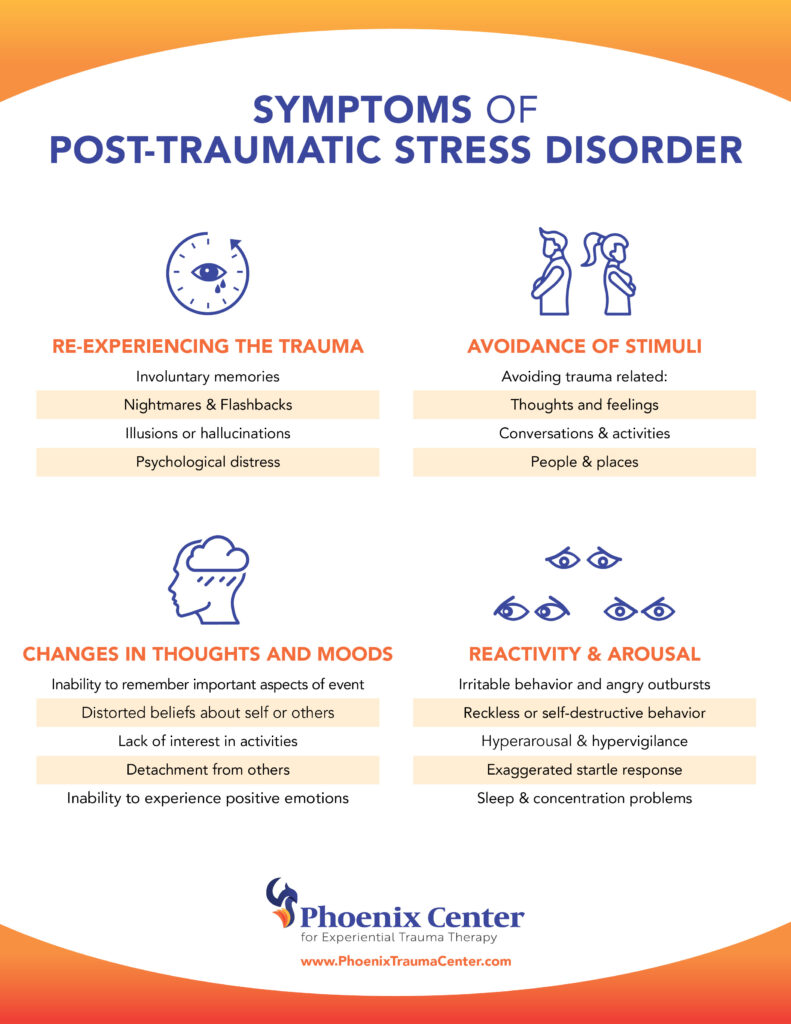Dr. Scott Giacomucci, DSW, LCSW, CTTS, CET III, PAT
Downloadable handout available here: https://www.phoenixtraumacenter.com/wp-content/uploads/2019/07/Trauma-and-PTSD22.pdf
Trauma exists upon a continuum or a spectrum. There are experiences that we often describe as capital “T” Traumas, and other experiences that we refer to as lower-case “t” traumas. Both can be equally disruptive in one’s life, especially when experienced over and over again. One of every four adults, and one of every two children, that experience a traumatic event will develop PTSD symptoms.
It seems appropriate that PTSD and trauma are often responded to with denial or dissociation – attempts to defend or protect one’s self from the vulnerability and reality of surviving a traumatic event. However, in order to fully recover from trauma and PTSD, one must come to a place of acceptance of their past. Post-Traumatic Stress Disorder (PTSD) is one of the most poorly understood mental health disorders. Interestingly, it is also one of the few diagnoses which asks, “what happened to you?” rather than “what is wrong with you?”.
What Is Trauma?
According to Dr. Peter Levine, an expert on traumatic stress:
“Trauma is a basic rupture – loss of connection to ourselves, our families, and the world. The loss, although enormous, is difficult to appreciate because it happens gradually. We adjust to these slight changes, sometimes without taking notice of them at all…although the source of tremendous distress and dysfunction, it (trauma) is not an ailment or a disease, but the by-product of an instinctively instigated, altered state of consciousness. We enter this altered state let us call it “survival mode” when we perceive that our lives are being threatened. If we are overwhelmed by the threat and are unable to successfully defend ourselves, we can become stuck in survival mode. This highly aroused state is designed solely to enable short-term defensive actions; but left untreated over time, it begins to form the symptoms of trauma. These symptoms can invade every aspect of our lives.”
One of the most effective ways to evaluate if you have been traumatized is to answer these simple questions about a significant incident: when you remember the incident, is the memory exactly the same every time? Or, is the memory fragmented or difficult to recall?
If an answer is yes, then the memory is likely a traumatic one. By no means does one traumatic memory constitute a diagnosis of PTSD; however, it does indicate that the traumatic event has been stored in an unprocessed manner and continues to cause you distress or require the defense of dissociation to avoid fully accepting what happened.
What is a PTSD Diagnosis?
The Diagnostic and Statistical Manual of Mental Disorders or DSM5, offers multiple criteria for a PTSD diagnosis.
The first criterion relates to the actual trauma:
- Directly experiencing the traumatic event(s)
- Witnessing, in person, the event(s) as it occurred to others
- Learning that the traumatic event(s) occurred to a close family member or friend
- Experiencing repeated or extreme exposure to aversive details of the traumatic event(s); this does not apply to exposure through media such as television, movies, or pictures
The next four criteria for PTSD are outlined in this graphic:

According to Levine, “The symptoms of trauma may be continually present or they may come and go. They may even surface after being hidden for decades. Usually, symptoms do not occur individually, but in clusters grow increasingly complex over time. Unfortunately, they become less and less connected with the original traumatic experience, making it increasingly difficult to trace the symptoms to their cause, and easier to deny the importance of the traumatic event in one’s life. However, if we pay attention to these symptoms, for what they are – internal wake up calls – we can address and begin to heal our trauma.”
Experiencing trauma and/or PTSD is not rare or uncommon. While many may suggest seeking treatment is a sign of weakness, we would argue that it is a tremendously courageous act. Though it may not feel possible at times, many trauma survivors report that they experienced growth and positive changes after a traumatic experience and/or the treatment of PTSD – this has been termed Post-Traumatic Growth.
Post-Traumatic Growth is not a new idea, it exists within all legends, myths, and holy books throughout time. The phenomenon of growing after hardship is quite common – nevertheless still remarkable. There are five common domains of post traumatic growth which include a new sense of personal strength, new possibilities, new appreciation of life, stronger emphasis on relationships, and spiritual/religious/existential changes. Even more hopeful, is the fact that around 2/3rds of trauma survivors report experiencing post-traumatic growth, making it more likely statistically than PTSD. After experiencing trauma, you are actually more likely to growth from it than to develop PTSD!
If you or someone you love may be impacted by trauma or post-traumatic stress, reach out to us for help at 610-203-2877

